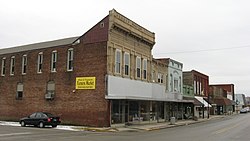Sheridan, Indiana
| Sheridan, Indiana | |
|---|---|
| Town | |

Main Street
|
|
 Location in the state of Indiana |
|
| Coordinates: 40°8′2″N 86°13′12″W / 40.13389°N 86.22000°WCoordinates: 40°8′2″N 86°13′12″W / 40.13389°N 86.22000°W | |
| Country | United States |
| State | Indiana |
| County | Hamilton |
| Township | Adams |
| Area | |
| • Total | 2.14 sq mi (5.54 km2) |
| • Land | 2.14 sq mi (5.54 km2) |
| • Water | 0 sq mi (0 km2) |
| Elevation | 951 ft (290 m) |
| Population (2010) | |
| • Total | 2,665 |
| • Estimate (2012) | 2,821 |
| • Density | 1,245.3/sq mi (480.8/km2) |
| Time zone | EST (UTC-5) |
| • Summer (DST) | EST (UTC-5) |
| ZIP code | 46069 |
| Area code(s) | 317 |
| FIPS code | 18-69354 |
| GNIS feature ID | 0443361 |
| Website | www.sheridan.org |
Sheridan is a town in Adams Township, Hamilton County, Indiana, United States. The population was 2,665 at the 2010 census. The center of population of Indiana is located just northwest of Sheridan.
Sheridan is located at 40°8′2″N 86°13′12″W / 40.13389°N 86.22000°W (40.133865, -86.220011).
According to the 2010 census, Sheridan has a total area of 2.144 square miles (5.55 km2), of which 2.14 square miles (5.54 km2) (or 99.81%) is land and 0.004 square miles (0.01 km2) (or 0.19%) is water.
Sheridan, once the second largest town in Hamilton County, lies on the south edge of land originally owned by George Boxley, a merchant and miller in Virginia who had fled from there ahead of bounty hunters because he was also an abolitionist suspected of fomenting a failed slave rebellion in 1815. Considerable recent development has greatly increased the population of this historic town. The Sheridan Downtown Commercial Historic District encompasses approximately four blocks along Main Street from the former Monon railroad right-of-way north to Veteran’s Park and Pioneer Hill, the site of the George Boxley Cabin, listed in the National Register of Historic Places.
The origins of Sheridan, which started out as Millwood, are vague, owing partly to the loss of all the town’s records in 1913 when a disastrous fire destroyed the town hall and many other buildings. No documentation supports the popular contention that Egbert Higbee started the town in 1860. Higbee, born in Ohio and brought to Adams Township as a child, did, indeed, lay out a town he called Millwood on land adjacent to the district school (built 1851) on the state road. He had acquired his land in parcels and filed his town plat in April 1866. Only two-and-a-half blocks divided into twenty lots, it was oriented in an east-west direction along the south side of the Lafayette-Noblesville state road, which Higbee designated as Main Street (present day Second Street; his “West Street” became Main). Higbee immediately began to sell off lots to enterprising merchants and a few mill owners, and the little village got its start. Higbee himself built a mill and laid out additions to his original plat. Caswell Boxley, however, subdivided the south edge of his land, which adjoined Higbee’s plat across the state road and he laid out his own plat of Millwood immediately north and extending west of Higbee’s. The initial town orientation was succeeded by one that placed Main Street in a north-south direction. In a few years the hamlet of Millwood applied for a post office and was granted one on January 30, 1871. Since there was already an existing post office in a village of the same name in Kosciusko County, this Millwood was rechristened “Sheridan,” in honor of Civil War general Philip Sheridan. The town had something of an identity crisis for a few years as some people continued to call it Millwood while others used the new name of Sheridan—even in official records. Its location on the state road connecting Noblesville and Lafayette was a good site for an agricultural center. By this time other entrepreneurs had laid out additions to Millwood as well, but growth was slow until the coming of the Monon Railroad in 1882 which stimulated a commercial and industrial boom. Several significant buildings from that early period survive, including the H.J. Thistlethwaite Building, constructed in 1886 to boast an opera house, a lodge room and retail spaces.
...
Wikipedia
